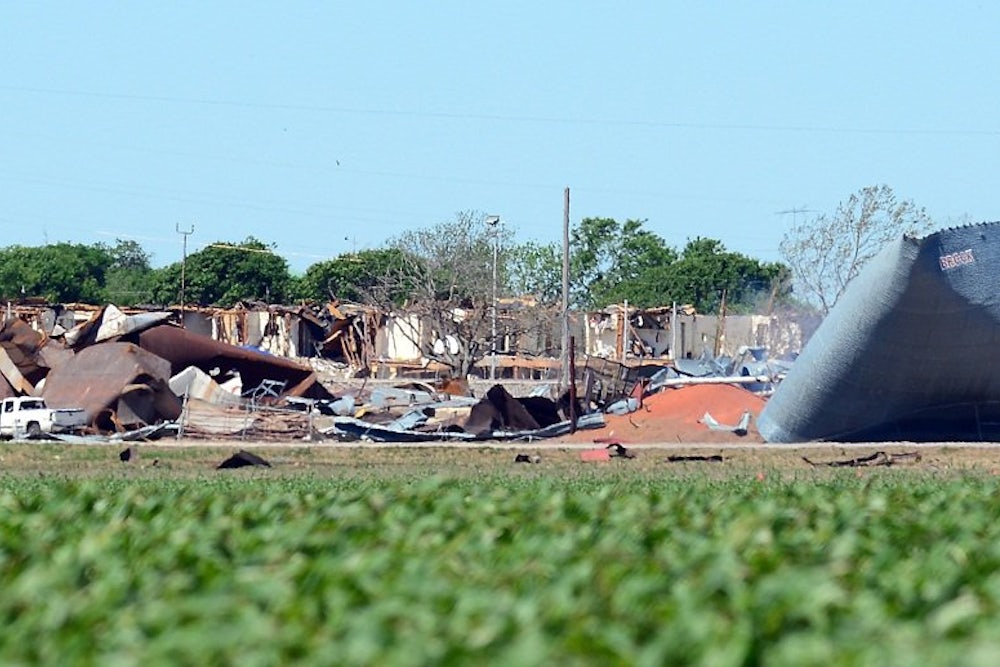We may not know for some time what caused the West Fertilizer Co. facility in West, Texas, to explode last week, killing 15 and injuring more than 200. But it is already clear that the warehouse, which housed two hazardous chemicals, was a regulatory nightmare. The Department of Homeland Security, did not even know the plant existed because West Fertilizer had failed to self-report its stores of ammonium nitrate. Occupational Safety and Health Administration inspectors had not been to the site since 1985. And in 2006 the Environmental Protection Agency fined the facility $2,300 for neglecting to update its risk management plan, but did not visit the premises again. The problem, as you might expect, is that these agencies don’t have enough field staff to check in regularly on every facility. The obvious solution—to increase funding for field staff—is always a difficult proposition, and even more so during sequestration.
But one chemical safety expert I spoke to proposed something entirely different: Make companies like West pay to regulate themselves.
This is neither as radical nor unrealistic as it may seem. While Americans rely on a taxpayer-funded regulatory system, in countries like the U.K., the government bills private companies for the cost of their own oversight. And a little more than a decade ago, the EPA explored this very framework—specifically, in fact, with regard to the chemical industry and risk management plans. “The people at the EPA were the first to make very, very clear that they didn’t have the ability to inspect all the facilities they were responsible for,” said Howard Kunreuther, a director at the Wharton School’s Risk Management and Decision Processes Center. “They knew that any company can make the following tradeoff: What’s the likelihood of getting inspected? Pretty low. What’s the cost of meeting regulations? Pretty high? And what’s the penalty if you’re ever caught? Maybe a few thousand dollars.”
The EPA, faced with this quandary, enlisted Kunreuther and his Wharton colleagues in the mid-‘90s to devise a solution that did not involve traditional regulators and budget increases. By the end of the 1990s, they had a scheme they were confident would work. Thousands of risk assessors, working with the insurance industry, already evaluate the risk management plans that companies must submit to the EPA. The EPA could simply have those third-party inspectors collect additional information for the EPA, and accept their reports in lieu of conducting their own inspections.
Enesta Jones, a spokesperson with the EPA, wrote in an email that the EPA actually tested the idea in Delaware and Pennsylvania, comparing reports compiled by the EPA with those compiled by insurance auditors who had been trained to collect the same information at 20 chemical facilities. The results were remarkably similar. Around the same time, Kunreuther began to model how the insurance industry could afford to lower premiums under such a scheme, because their clients would operate more safely—a financial incentive for the chemical industry to support the idea voluntarily. He found that by reducing uncertainty, environmental auditing causes insurers to lower premiums by about half. Taxpayer dollars, furthermore, would be spent more effectively, as regulators would be free to focus on the “big polluter” firms that did not opt for third-party inspection. Without requiring third-party involvement—just by making the option available—the EPA could still vastly reduce the thousands of facilities it is required to inspect today.
“The EPA was very enthusiastic about this idea,” he said. And yet, the idea went nowhere. According to Kunreuther, support for this regulatory change dried up abruptly after 9/11; the attacks altered the EPA’s role drastically. “They were concerned about issues of air quality. They were concerned about terrorist targets,” Kunreuther recalled. “What they weren’t concerned about was worst-case-scenario accidents at chemical firms, and third-party risk management.” Jones said that there were many reasons to drop the proposal—implementing an all-new regulatory apparatus is not a cheap, easy task. Instead, the EPA merely chose to “endorse the concept of offering sources the option of using third parties,” according to Jones.
This approach has worked before, both abroad and in the U.S.: Michigan recently moved to regulate gas stations’ underground storage tanks in this way, at a savings of $400 billion over eight years in spill-cleanup costs. There’s no better time than now for the EPA to revisit it, as the West explosion has rallied people to the cause of regulatory reform. But it’s also a solution perfect for this age of austerity hysterics: Nothing changes minds like a penny saved.
Follow me on Twitter @mtredden
